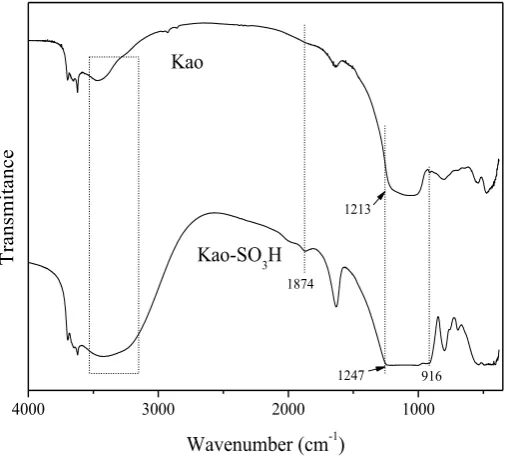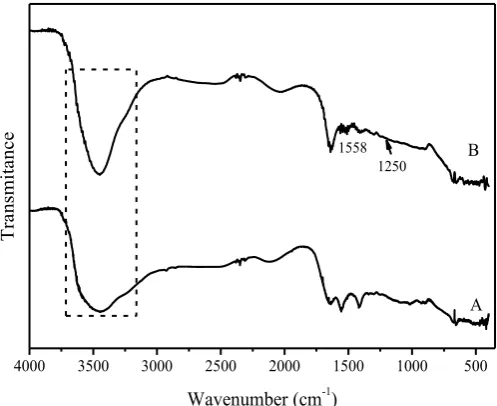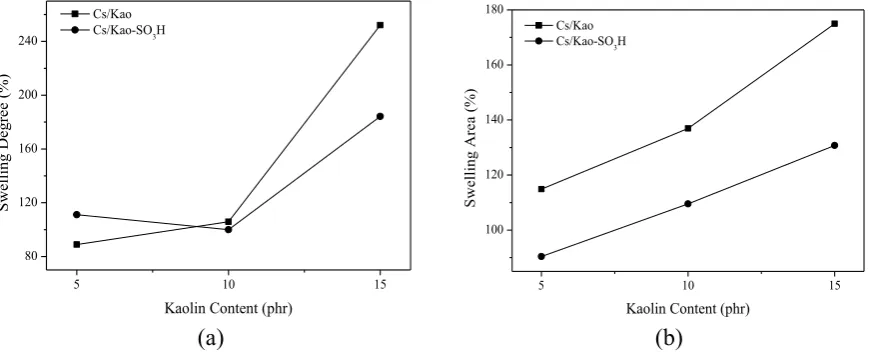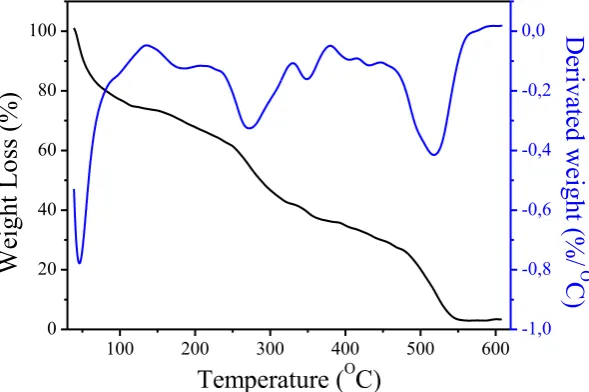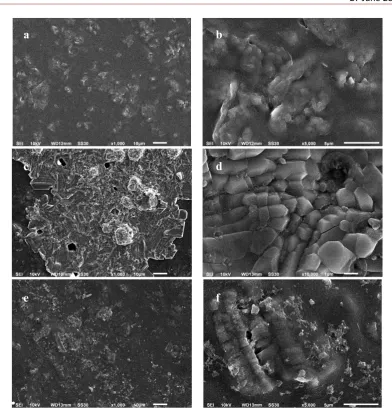The journal homepage www.jpacr.ub.ac.id p-ISSN : 2302 – 4690 | e-ISSN : 2541 – 0733
Influence of Sulfonated-Kaolin On Cationic Exchange Capacity
Swelling Degree and Morphology of Chitosan/Kaolin Composites
Ozi Adi Saputra,1 Dheo Adha Saputra,1 Kartika Setia Rini,1 and Edi Pramono1*
1
Chemistry Department, Sebelas Maret University, Jl. Ir. Sutami 36A Surakarta, Indonesia
*
Corresponding email : [email protected]
Received 27 March 2016; Revised 26 May 2016; Accepted 27 June 2016
ABSTRACT
Preparation of sulfonated-kaolin (sKao) has been conducted and used as filler on chitosan matrix via solution casting method, namely chitosan/sKao (Cs/sKao). Swelling degree, cationic exchange capacity and thermal stability were evaluated to determine chitosan/sKao membranes performance as proton exchange membrane in a fuel cell. Functional group analysis of chitosan, sKao and synthesized products were studied using Fourier Transform Infra-Red (FTIR) spectroscopy. In this study, swelling degree and swelling area of Cs/sKao were also examined to determine of membrane ability to swelling which compare to unmodified chitosan/kaolin (Cs/Kao). The presence of sKao in chitosan matrix was able to improve cationic exchange capacity (CEC) which proved by the morphological study of membrane surface after CEC test. Moreover, Thermal stability of Cs/sKao showed the membrane has meet requirement for Proton Exchange Membrane (PEM) application.
Keyword: Cationic Exchange Capacity, Chitosan, Membrane, Proton Exchange Membranes, Sulfonated-Kaolin
INTRODUCTION
Research and technology development, especially in membrane technology field is increasing worldwide. Membrane technology provided a simple, easier and economical technology in various application fields such as purification, water treatment, membrane fuel cell and many others [1-4]. The important part in fuel cell components are proton exchange membrane (PEM) [5]. Nowadays, Nafion® is still favorable electrolyte membrane for fuel cell application, due to it has good performance in membrane fuel cell technology, but high cost and they were not stable in high temperature over than 110 ᴼC [6]. Therefore, many researches have been developed new materials which have good proton conductivity, high proton exchange capacity, high termal stability and low cost.
Chitosan is interesting to be studied by many researchers due their properties, such as biodegradability, non-toxic, abundantly, and low cost [11]. Modified chitosan to obtained material which has unique properties such as high proton conductivity and proton exchange capacity was studied [8,12]. Bai et al. [8] has been using sulfonated-Halloysite nanotubes (HNTs) as filler in chitosan membrane and found that the proton exchange capacity has increased. However, it was relatively high cost and energy to obtain halloysite with nanotubes form, so another alternative was required such as using kaolin which has the same chemical structure like halloysite, as filler on chitosan membrane.
Based on the literature review, effect of sulfonated-kaolin on cationic exchange capacity of chitosan/kaolin membrane performance has not yet studied. Thus, in this work has been successfully prepared sulfonated-kaolin and continuously fabricated with chitosan as chitosan/sKao membrane. Cationic exchange capacity, swelling degree properties, as well as the thermal stability of these membranes, were tested and found that the Cs/sKao has a meet requirement as PEM in a fuel cell.
EXPERIMENT Materials
Raw material such as chitosan (Cs) obtained from PT. BIOTECH SURINDO, Indonesia with medical grade, natural kaolin (Kao) was obtained from PT. Brataco, Indonesia. All reagent which used in this study were purchased from Merck without purification, except mentioned, such as sulfuric acid (H2SO4), sodium hydroxide (NaOH), sodium chloride
(NaCl) and acetic acid (CH3COOH). All reagent; H2SO4, NaOH, NaCl and CH3COOH were
prepared in concentration 15% (v/v), 0.01 M, 2 M, and 1.5% (v/v), respectively.
Preparation of Sulfonated-kaolin (sKao)
Preparation of sulfonated kaolin (sKao) was according to previous report [13]. About 2 g of Kaolin which calcinated at 400 ᴼC was placed at three neck bottom flask and poured with 50 mL H2SO4 (15% v/v). The mixture solution was stirred and heated up to 80-90 ᴼC about 4
hours. The product was washed with distilled water to remove unreacted H2SO4. FTIR
spectrophotometry technique was used to monitored of Sulfonated-Kaolin (sKao).
Table 1. Cs/Kao and Cs/s-Kao hybrid membranes formulation
Composites Chitosan
solution and stirred for 1 hour. The mixture solution was poured in the plastic dish template and dried at 50 ᴼC for 24 hours. The final product in the form of a thin film membrane with a thickness of 0.093mm ± 0.002 mm.
Characterization
The functional group of materials (chitosan, kaolin, sKao and Cs/sKao) were characterized using FTIR (Fourier Transform Infra-Red) spectroscopy IR Prestige 21 SHIMADZHU, which records in range 450-4000 cm-1 at 45 number of scans. In this study, KBr was used as background as well as in the preparation of sample into pellet form.
Both Cs/Kao and Cs/sKao were cut into small pieces (1 x 1 cm2, approximately) and record as initial weight (Wo). About 15 mL of NaCl solutions were added to the container which contained with membranes. The mixture was stirred about 1 hour and immersed for 24 hours. Five mL of NaCl solution were taken from the container and titrated with NaOH 0.01 M to determine cation exchange capacity (CEC) with equation 1.
(1)
Swelling degree test was performed in a bath containing water. Dry membranes were weighted (Wo) and immersed in water. After 1 hour, the membranes weight was recorded as final weight (Wi). The swelling degree was calculated with equation 2. In this study, swelling area (%) also performed by measuring its area difference before (Ao) and after (Ai) immersion in water. The swelling area was calculated with equation 3.
(2)
(3)
Thermal stability of Cs/sKao-10 membranes was evaluated using Simultaneous Thermal Analyzer (STA) Lineises PT-1600. The test was recorded in air atmospheric with heat speed of 10 ᴼC/min. Differential Thermal Gravimetric (DTG) curve in this study was obtained from differentiated TGA data as temperature function using OriginPro 8 software.
Morphology study was performed using SEM (Scanning Electron Microscopy) JEOL/EO JSM-6510. The sample which is used in this study is Cs/SKao hybrid membranes, before and after CEC test.
RESULT AND DISCUSSION
Synthesis of sulfonated-kaolin (s-Kao) and the hybrid membrane
Modification of kaolin with sulfonate group was successfully performed. It was evidenced by functional group analysis by FTIR which was shown in Fig. 1. The shift of wavenumber from FTIR spectrum of kaolin in the sKao spectrum indicated that an alteration of the chemical structure of kaolin. Hydroxyl group peak at SKao spectrum is broader than Kao spectrum, due to hydrogen bonding interaction with the presences of a sulfonate group in kaolin as showed in Fig. 2. The stronger absorbance at near 3400 cm-1 of SKao was corresponding to water molecules in inner kaolin, due to hydrophilic –SO3H which enhances
1024 cm-1 has not found because of overlapped by the strong and broad band of Kao at around 1124 cm-1. The FTIR spectrum of sKao also showed a shift of characteristic bands at 916 cm-1 which corresponding to Al-O, also for the strong and broad band around 1000-1100 cm-1 probably attributed to the stretching vibration of Si-O-Si groups. This fact indicated that SO3H group attached to Al-O or at Si-O groups.
Figure 1. FTIR spectrum of Kao and s-Kao
Preparation of Cs/Kao and Cs/sKao membranes were achieved by solution casting method. Kao or sKao were successfully embedded into Cs matrix. SEM image of membranes surface showed that SKao has good dispersion in Cs matrix as seen in Fig. 8a. It indicated that between Cs matrix and SKao filler has good chemical and physical interaction, due to both chitosan and kaolin were polar molecules, so make it easy to interact. However, aggregation is also found in several spot showed by Fig. 8b. It is possible for the low adhesion interaction between chitosan matrix and kaolin’s layer. Another possibility is the failure of chitosan-kaolin intercalation effect, then resulted in poor interaction between chitosan and kaolin [14,15].
Figure 2. Hydrogen bond intermolecular of s-Kao
In this study, FTIR technique was also performed for chemical investigation. The characteristic band of chitosan peak at around 3080 cm-1 to 3600 cm-1 which corresponding to N-H stretching vibration was not investigated in Cs/SKao FTIR spectrum (see Fig. 3), since of overlapping with hydroxyl (-OH) absorbance band at around 3447 cm-1. The increasing of hydroxyl absorbance band intensity was caused by the higher of hydroxyl content which is contributed of both chitosan and sKao. In another side, absorbance band at 1250 cm-1 and 1558 cm-1 which characteristic to asymmetric O=S=O stretching and N-H bending vibration, respectively in Cs/sKao FTIR spectrum were shifted from their raw material FTIR spectrum.
4000 3000 2000 1000
1247 1874
1213
Tr
a
nsmi
ta
nc
e
Wavenumber (cm-1)
916
This is caused by chemically interaction between chitosan and SKao, where attributed to the amine group (-NH2) binding in kaolin interlayer via hydrogen bonding [16,17].
Figure 3. FTIR spectrum of Cs/sKao composites
Cation Exchange Capacity
Cation exchange capacity (CEC) reflected the number of cation (in this study is Na+ ion) exchange with a proton. Fig. 4 showed CEC value of the membranes. The increasing of sKao content was able to improve the CEC value of the membrane. For example, the addition of 10% of SKao content was able to increase CEC value 0.24 mmol.g-1 compare to 5% of sKao 0.17 mmol.g-1. It is caused by attributed to active groups both on chitosan and SKao. Chitosan is biopolymer contained with two functional group, hydroxyl OH) and amine (-NH2) [2,12]. Both of functional groups were known as an active site for chemical interaction
[18]. However, for only amine group is act as the proton exchange active site. Moreover, sKao also has sulfonates groups as their active group. The presences of the amine group of chitosan and sulfonate group of kaolin were able to attach the cation which contacts with the membranes [18,19].
The CEC value of Cs/Kao hybrid membrane decreased with increasing of Kao content. It can be seen in Fig. 4, the addition of 5, 10 and 15% of kaolin in chitosan matrix has CEC value of 0.15, 0.14 and 0.11 mmol.g-1, respectively. The decreasing of CEC value in Cs/Kao hybrid membrane due to the presence of amine group which acts as an active site of chitosan in proton exchange was reduce. It is caused by of amine group of chitosan has chemically interaction with kaolin via hydrogen bonding, thus when the higher addition of kaolin content in chitosan matrix will causing of hydrogen bonding or interaction between chitosan and kaolin increased. So that, the decrease of amine group also decreasing of the active site to proton exchange.
4000 3500 3000 2500 2000 1500 1000 500
Figure 4. CEC value of the membranes
Fig. 5 showed an infra-red spectrum of Cs/sKao hybrid membranes before and after CEC test. It can be seen that, after CEC test, the absorbance peak at 3454 cm-1 is less broad than before. This indicated that hydrogen atom of amine group had exchanged with Na+ ions, so hydrogen bonding in amine group was reduced and affect in sharping of the absorbance peak. In another hand, the intensity of peak at around 1558 cm-1 and 1250 cm-1 were reduced, this probably of hydrogen atom both in amine and sulfonate group was exchanged cause reduction in N-H bending and sulfonate vibration peak. Base on this data, it was evidenced that cationic exchange process was successfully achieved.
Figure 5. FTIR spectra of Cs/sKao (A) before and (B) after CEC test
Swelling Degree Properties
Swelling degree is the ability of material to swell when it immersed in several solvent [4], such as water. In this study, Cs/Kao and Cs/sKao was immersed in water for 1 hour at room temperature. Both membranes show significant improvement of swelling ability which shown by Fig. 6a. Generally, swelling degree of Cs/sKao was lower than Cs/Kao. Modification of Kao with the –SO3H group was able to reduce the water absorption ability of
kaolin [8]. This reduction was caused by an intermolecular hydrogen interaction of sKao
4000 3500 3000 2500 2000 1500 1000 500
which shown in Fig. 2, this interaction has an effect on the reduction of sKao polarity. Thus, it was influenced by the reduction of water uptake ability of Cs/sKao hybrid membrane. In another hand, the higher of Kao or sKao content in Cs matrix was able to increase of swelling degree properties. Chitosan membrane filling with Kao or sKao with 15% of concentration has swelling degree up to 252.17% and 184.21% respectively. Kaolin was a polar compound [15,20], which showed by the presences of hydroxyl groups, thus it causes an increase of swelling degree ability in the membrane which has higher Kao or SKao content.
(a) (b)
Figure 6. Swelling degree and area of Cs/Kao and Cs/sKao membranes
The swelling area is one of the crucial factors in PEM. Fig. 6b showed an increasing of swelling area was achieved by increasing of both Kao and sKao content in Cs membranes. For example, loading of 5% to 15% of Kao increased swelling area from 114.88% to 175%. Also for sKao at 5% to 15% content increased from 90.38% to 130.77%. Swelling area trends were similar with swelling degree trends, while Cs/sKao has swelling area lower than Cs/Kao. It indicated that modification of kaolin with the addition of –SO3H groups has high
influence in swelling area value.
Thermal Properties of The membranes
PEM as the main part of fuel cell must have excellent thermal stability. In this study, the thermal stability of the optimum membrane (the membrane has high CEC value, in this case is Cs/s-Kao10) was evaluated by TGA analysis, shown in Fig. 7. In this investigation, it was clearly seen that the Cs/s-Kao10 have four steps weight loss stage based on DTG curve: (a) the first stage is water release from membrane around 30-110 ᴼC; (b) the second stage is degradation of chitosan around 149-320 ᴼC; (c) the third stage is degradation of sulfonate groups around 330-360 ᴼC; and the last is degradation of chitosan polymer backbone as well as the forming of kaolin char. The presence of s-Kao in Cs membrane was able to act as thermal stabilizer due to clay has an endothermic reaction when degraded and it can release water vapor and char which act as a flame barrier in combustion [21,22]. The addition of 10% of sKao into Cs matrix has 4% of char, indicated that in the burning process, some of the layered clay formed moiety to decrease thermal combustion and the others formed char with chitosan polymer backbone. The forming of char is suggested that the membrane has excellent thermal stability. In another side, sulfonate group which is degraded around 330-360 ᴼC, was initiated thermal degradation of chitosan polymer backbone. It has negative impact on thermal stability of the membrane. This result also found by Klaysom [10] works,
wherein the addition of sulfonate group into polymer has reduced thermal stability. However, considering on the operating temperature where PMFC is working at temperature range of 80-110 ᴼC, this membrane has to meet thermal stability requirements.
100 200 300 400 500 600
Figure 7. TGA and DTG curve of Cs/s-Kao10 membranes
Morphological Study
Cs/sKao membrane before and after CEC test has different morphology appearance. The sKao was attached in membrane surface, which is showed in Fig. 8a. It can be seen in Fig. 8b that the presence of sKao on membare surface causes the membrane has porous in their surface. After CEC test, an aggregate has found as seen in Fig 8c, which is corresponding to NaCl crystal (Fig. 8d). This evidence by SEM-EDX analysis, wherein Fig. 8c has contained Na and Cl relatively high up to 15.25% and 12.27% atoms, respectively.
Table 2. Atom percentage analysis based on SEM-EDX data of Cs/sKao
Figure 8. SEM image of Cs/sKao membrane at (a) 1000x and (b) 5000x magnification; Morphology of Cs/sKao after CEC test at (c) 1000x and (b) 5000x magnification; Another morphology of Cs/sKao after CEC test at different spot (e) 1000x and (b) 5000x magnification.
CONCLUSION
This work was conducted to study of kaolin modification with sulfonate group and their influence as filler in chitosan matrix on cation exchange capacity, swelling degree and area properties as well as in chemical and morphological analysis. Modification of Kaolin with addition sulfonate group has high influence in cation exchange capacity, swelling degree and swelling area properties. Cs/sKao has higher CEC value than Cs/Kao, due to the presence of sulfonate group in kaolin. The cationic exchange of Cs/sKao hybrid membrane was evidence by chemically using FTIR analysis and physically using SEM analysis. In another hand, Cs/sKao has lower both swelling degree and swelling area properties. The morphological study has been confirmed that the presence of SKao was able to attract the Na+ ions.
ACKNOWLEDGMENT
Author(s) would like to acknowledge to Sebelas Maret University for financial support from Program Kreatifitas Mahasiswa DIPA (PKM-DIPA) 2015 grant.
a b
c d
REFERENCES
[1] Peng, Y., Lu, H., Wang, Z. and Yan, Y., J. Mater. Chem. A., 2014, 2, 16093-16100. [2] Annadurai, G., Bioprocess Eng., 2000, 23, 451-455.
[3] Kiakhani, M.S., Arami, M. and Gharanjig, K., J. Environ. Chem. Eng., 2013, 1, 406-415.
[4] Mukoma, P., Jooste, B.R. and Volsloo, H.C.M., J. Power Sources., 2004, 136, 16-23. [5] He, Y., Tong, C., Geng, L., Liu, L. and Lu, C., J. Membrane Sci., 2008, 458, 36-46. [6] Ahmed, M. and Dincer, I., Int. J. Energ. Resour., 2011, 35, 1213-1228.
[7] Mistri, E.A., Mohanty, A.K., Banerjee, S., Komber, H. And Voit, B., J. Membrane Sci., 2013, 441, 168-177.
[8] Bai, H., Zhang, H., He, Y., Liu, J., Zhang, B. and Wang, J., J. Membrane Sci., 2014, 454, 220-232.
[9] Ozer, O., Ince, A., Karagoz, B. and Bicak, N., Desalination., 2013, 309, 141-147. [10] Klyasom, C., Ladewig, B.P., Lu, G.Q.M. and Wang, L., J. Membrane Sci., 2011, 368,
48-53.
[11] Cestari, A.R., Vieira, E.F.S., Tavares, A.M.G. and Bruns, R.E., J. Hazard. Mater., 2008, 153, 566-574.
[12] Daraei, P., Madaeni, S.S., Salehi, E., Ghaemi, N., Ghari, H.S., Khadivi, M.A. and Rostami, E., J. Membrane Sci., 2013, 436, 97-108.
[13] Park, S.S., Hwang, E.H., Kim, B.C. and Park, H.C., J. Am. Ceram. Soc., 2000, 83, 1341-1345.
[14] Zhang, B., Li, Y., Pan, X., Jia, X. and Wang, X., J. Phys. Chem. Solid., 2007, 68, 135-142.
[15] Olejnik, S., Posner, A.M. and Quirk, J.P., Clay Miner., 1970, 8, 421-434.
[16] Valášková, M., Rieder, M., Matějka, V. and Čapková, P., Appl. Clay Sci., 2007, 35,
108-118.
[17] Ismail, H., Khoo, W.S. and Ariffin, A., J. Vinyl Addit. Technol., 2013, 19(1), 55-64. [18] Mohamed, N.S., Subban, R.H.Y. and Arof, A.K., J. Power Sources., 1995, 56,
153-156.
[19] Wang, F., Hickner, M., Kim, Y.S., Zawodzinski, T.A. and McGranth, J.E., J.
Membrane Sci., 2002, 197, 231-242.
[20] Sugahara, Y., Satokawa, S., Yoshioka, K.I., Kuroda, K. and Kato, C., Clay Clay
Miner., 1989, 37, 143.
[21] Jimenez, M., Duquesne, S., and Bourbigot, S., Ind. Eng.
Chem. Res., 2006, 45, 4500-4508.
